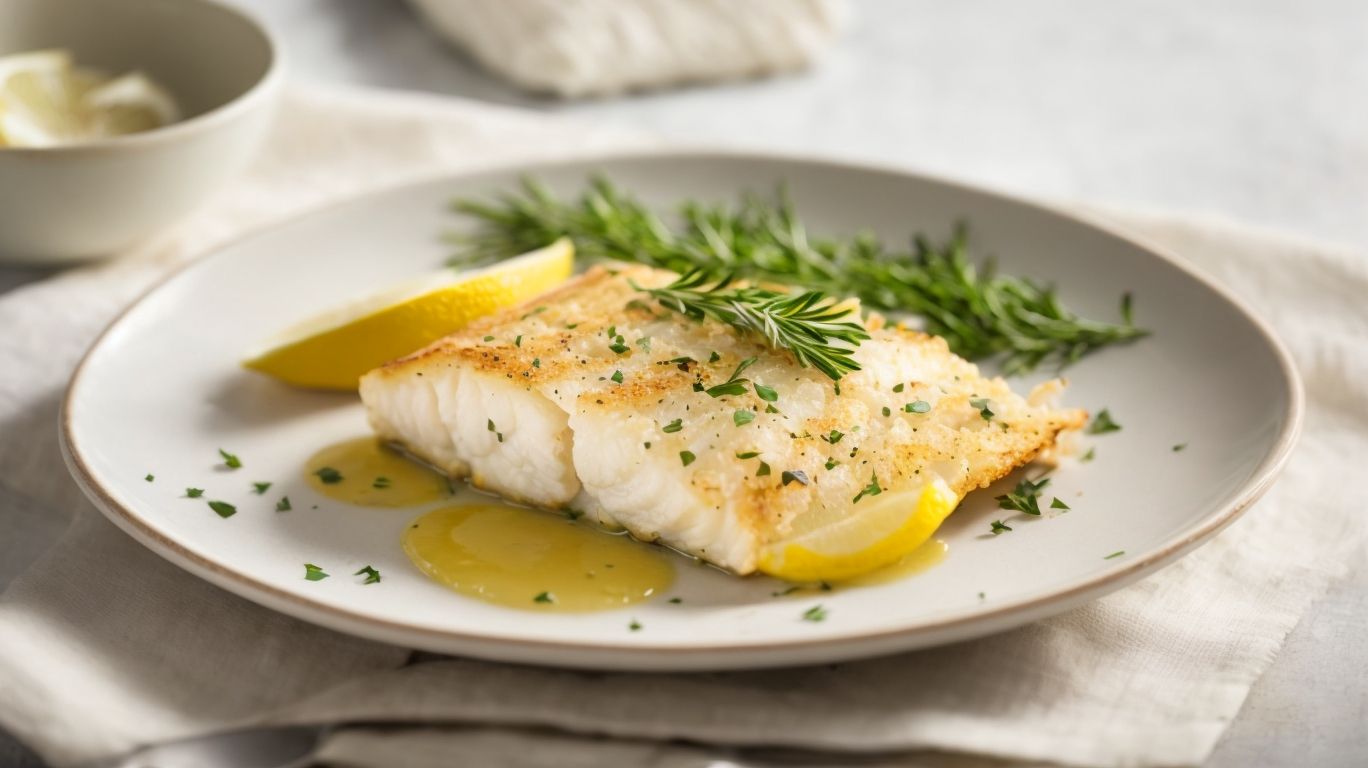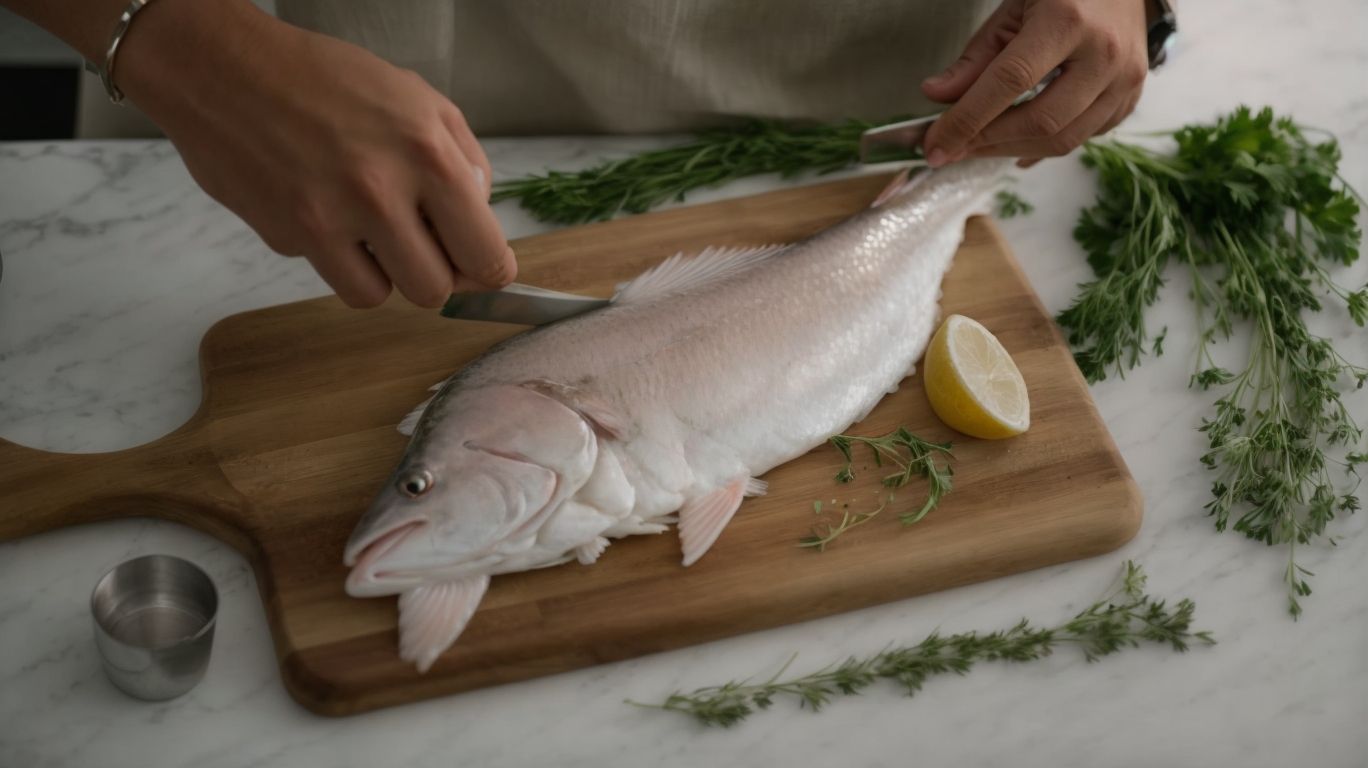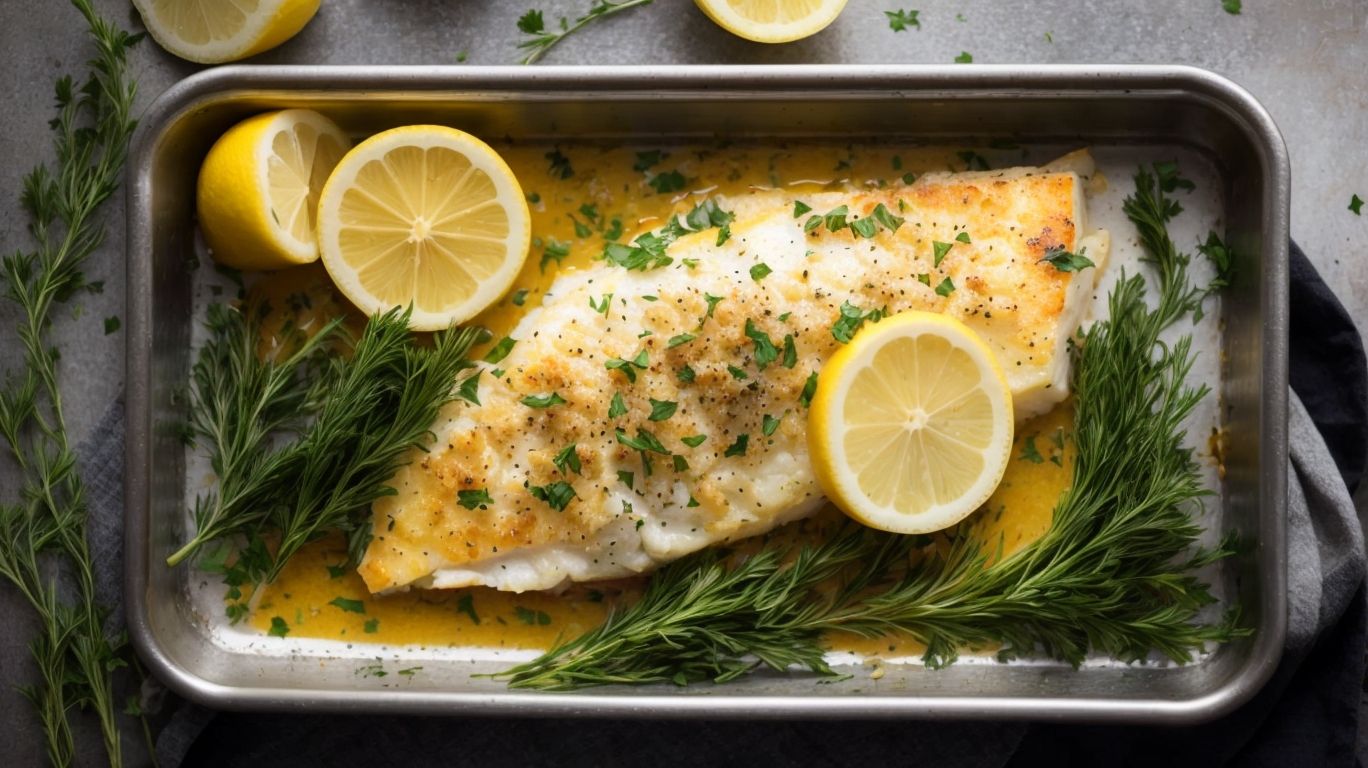How to Bake Haddock?
Looking to impress your dinner guests with a delicious and easy-to-make seafood dish? Check out my guide on how to bake haddock!
In this article, I’ll walk you through everything you need to know about haddock – from what sets it apart from other types of fish to the essential ingredients and equipment you’ll need for baking.
I’ll also share step-by-step instructions on how to prepare and bake the haddock to perfection, along with serving and pairing suggestions to elevate your meal. Let’s dive in and get cooking!
Key Takeaways:
What is Haddock?

Credits: Poormet.Com – James Adams
Haddock, a type of fish commonly found in New England waters, is known for its tender, flaky texture and mild flavor.
Its delicate flesh makes it a popular choice for various culinary dishes. Haddock is often baked, grilled, or fried to perfection, resulting in a dish that is both crispy on the outside and tender on the inside. A classic preparation involves coating Haddock fillets in breadcrumbs before cooking, creating a deliciously crunchy crust that complements the fish’s natural flavors.
How is Haddock Different from Other Types of Fish?
Compared to other types of fish, Haddock stands out for its delicate flakiness when cooked and the crispy texture it develops when baked.
When seasoned and cooked with a blend of garlic, lemon, and parsley, Haddock takes on a whole new level of flavor profile. The garlic infuses a savory depth, the lemon adds a refreshing zest, and the parsley brings a herbaceous note to the dish. The white flesh of Haddock lends itself well to absorbing these flavors, resulting in a harmonious combination that tantalizes the taste buds.
The flaky nature of Haddock allows it to easily break into tender, moist chunks, making it a perfect choice for fish cakes, chowders, or simply pan-searing for a quick and nutritious meal. The subtle sweetness of Haddock pairs beautifully with the piquant elements of the seasoning, creating a balanced and satisfying dining experience.
What You Will Need
To prepare a delicious Baked Haddock dish reminiscent of New England flavors in your home kitchen, you will need a few essential ingredients and equipment.
For the ingredients, you will need fresh Haddock fillets, olive oil, lemon, salt, pepper, and a touch of paprika for that extra flavor. As for tools, gather a baking sheet, aluminum foil, a pair of cooking tongs, and a brush for spreading olive oil. Preheat your oven to 400°F (200°C) to ensure it’s ready for baking. The prep time for this dish is around 10-15 minutes, making it a quick and convenient choice for a flavorful fish dinner.
Ingredients for Baking Haddock
The ingredients for baking Haddock include breadcrumbs for a crispy coating, butter for rich flavor, garlic for added depth, and lemon for a zesty touch.
One key ingredient that contributes to the overall flavor profile of the dish is thyme. Its earthy and slightly minty undertones marry well with the delicate taste of Haddock, adding a herbaceous note to each bite.
A generous sprinkle of grated Parmesan over the breadcrumb mixture before baking not only enhances the texture by creating a crispy golden crust but also infuses a savory umami richness to the dish.
For those looking to reduce sodium, opting for a low-sodium Parmesan or even nutritional yeast can still offer a similar depth of flavor without the salt content.
When considering the Nutrition Facts, this dish can be made healthier by using whole wheat breadcrumbs and reducing the butter quantity while still maintaining a delicious final product.
Equipment for Baking Haddock
In your home kitchen, you will require basic cooking equipment to bake Haddock efficiently, with the total cook time varying based on the recipe and oven temperature.
Essential kitchen tools for baking Haddock include a baking sheet, parchment paper, a mixing bowl, measuring cups and spoons, a whisk, and a kitchen thermometer to ensure the fish reaches the proper internal temperature for safe consumption.
Proper equipment usage is crucial in achieving a perfectly cooked dish; for instance, preheating the oven to the recommended temperature will help cook the Haddock evenly.
Managing cook time effectively can be done by following precise instructions from reputable sources like Allrecipes Test Kitchen or the Culinary Institute of America, ensuring your dish is flavorful and cooked to perfection.
Preparing the Haddock

Credits: Poormet.Com – Bryan Campbell
Before baking Haddock, it is crucial to clean and debone the fish properly, followed by marinating it to enhance the flavors and moisture retention during cooking.
Start the cleaning process by rinsing the Haddock under cold water to remove any remaining scales or residue. Ensure to pat it dry gently with paper towels. Next, carefully remove the bones using a sharp knife, making incisions along the backbone on either side to ensure most bones are eliminated.
After deboning, prepare a flavorful marinade with ingredients like olive oil, lemon juice, minced garlic, and a sprinkle of salt and pepper to infuse the fish with a delightful taste. Let the Haddock sit in the marinade for at least 30 minutes to allow the flavors to penetrate.
Consider serving the baked Haddock alongside Roasted New Potatoes and a side of Asparagus for a well-rounded meal that pleases the palate with a combination of textures and tastes.
Cleaning and Deboning the Haddock
Cleaning and deboning Haddock involves removing scales, guts, and bones meticulously to ensure a clean fillet for cooking, maintaining the fish’s integrity.
Before starting the cleaning process, it’s essential to prepare a clean workspace and gather necessary tools such as a sharp fillet knife, cutting board, and gloves for safety. Caution should be taken when handling sharp objects to prevent accidents.
- Begin by descaling the fish, scraping off the scales with a knife or scaler to reveal the skin.
- Next, carefully gut the Haddock by making a precise incision along the belly and removing the entrails.
- To debone, gently run the knife along the backbone, separating the flesh from the bones without compromising the fillet.
Proper technique ensures a seamless fillet for your desired dish like a flavorful Caesar Salad.
Marinating the Haddock
Marinating Haddock with a blend of parsley, thyme, garlic, and lemon infuses the fish with aromatic flavors and tenderizes the flesh for a delightful dining experience.
When creating a marinade for Haddock, chefs like Bailey Fink, Deborah Dagrosa, and StephMcCaf often experiment with various combinations to achieve the perfect balance of flavors. Some opt for a citrus-based marinade with lemon and lime, while others lean towards a more herbaceous blend with rosemary and basil.
The duration of marination plays a crucial role in determining the depth of flavor. For a quick infusion, marinate the Haddock for at least 30 minutes, but for a more intense flavor profile, consider leaving it in the marinade for up to 2 hours.
Baking the Haddock
Baking Haddock to perfection requires following precise step-by-step instructions and incorporating helpful tips to achieve a crispy, golden exterior and tender, flaky interior.
Preheat your oven to 400°F to ensure the ideal temperature for baking Haddock. While the oven warms up, prepare a baking dish by greasing it lightly to prevent sticking. Season the Haddock fillets with a blend of herbs and spices such as parsley, thyme, and a hint of lemon zest for added flavor.
Once seasoned, place the fillets in the prepared dish and bake for approximately 20-25 minutes, or until the flesh becomes opaque and easily flakes with a fork. To ensure an even cook, consider rotating the dish halfway through the cooking process to promote uniform browning.
Step-by-Step Instructions for Baking Haddock
Following precise step-by-step instructions is crucial for baking Haddock in the oven, ensuring even cooking and optimal flavor development.
To start, preheat the oven to 375°F for a perfect balance of heat without risking overcooking. Meanwhile, prepare a mixture of Jill Mordovanec’s special blend of herbs and spices to coat the Haddock fillets, infusing them with a burst of flavor. Before placing them in the oven, it’s essential to lightly brush each fillet with melted butter, adding a rich and creamy texture to the dish. A sprinkle of salt over the top not only enhances the taste but also helps with moisture retention during baking.
Tips for Perfectly Baked Haddock
To achieve perfectly baked Haddock, consider tips such as preheating the oven, using quality ingredients, and monitoring the cooking time for a crispy, flaky result.
Another crucial step in baking the ideal Haddock is to prepare a flavorful seasoning mix to enhance its taste profile. Incorporating a blend of pepper, lemon zest, garlic, and herbs not only adds depth to the dish but also complements the natural flavors of the fish.
When cooking Haddock, it’s essential to pay attention to its Nutrition Facts to ensure a balanced meal. Opt for whole ingredients and avoid excessive use of salt or heavy creams to maintain a wholesome and nutritious dish.
For a visually appealing presentation, consider garnishing your baked Haddock with fresh parsley, a squeeze of lemon, and a drizzle of high-quality olive oil. This simple yet elegant touch elevates the dish and makes it a feast for both the eyes and taste buds.
Serving and Pairing Suggestions
Enhance your Baked Haddock dining experience by serving it alongside complementary side dishes and pairing it with the perfect wine selection to elevate the flavors.
In terms of selecting side dishes for your Baked Haddock, opt for garlic mashed potatoes or a lemon-herb quinoa pilaf to add depth and richness to the meal. The earthy flavors of thyme can also be infused into roasted vegetables such as carrots or asparagus for a harmonious pairing. A fresh green salad with a tangy vinaigrette can provide a refreshing contrast to the dish.
For beverages, consider serving a crisp Sauvignon Blanc with its citrus notes that complement the haddock’s delicate flavors. Alternatively, a light-bodied Chardonnay can enhance the richness of the fish without overpowering it. For non-alcoholic options, a sparkling water with a twist of lemon or a fruity iced tea can be excellent choices to cleanse the palate between bites.
Best Side Dishes for Baked Haddock
Complement your Baked Haddock with flavorful side dishes like Asparagus spears and Roasted New Potatoes, adding a variety of textures and tastes to your meal.
For a burst of freshness and color on your plate, consider adding a vibrant parsley garnish to your dishes. The bright green hue and earthy flavor of parsley can elevate the visual appeal and taste profile of your meal.
Pairing the Baked Haddock with a crisp Caesar Salad can provide a contrast in flavors and textures, offering a refreshing accompaniment to the rich fish.
When plating, take inspiration from renowned chef Linda and focus on creating a visually appealing arrangement that entices both the eyes and the taste buds.
Recommended Wine Pairings
For an ideal dining experience, consider pairing Baked Haddock with wines like Chardonnay or Pinot Grigio, which complement the dish’s flavors and enhance the overall meal.
Chardonnay, known for its crisp apple and citrus notes, beautifully contrasts the flaky texture of the haddock, enhancing its delicate flavors. On the other hand, Pinot Grigio with its light, refreshing profile, complements the dish’s buttery elements, creating a harmonious balance on the palate.
When serving Baked Haddock, ensure the white wine is chilled to perfection, around 45-50°F (7-10°C), to preserve its freshness and acidity, maximizing the dining experience.
Frequently Asked Questions
What is haddock and how is it different from other fish?
Haddock is a type of white fish that can be found in the North Atlantic Ocean. It is known for its lean and flaky texture, making it a popular choice for baking. Haddock is similar to cod, but has a slightly sweeter flavor.
What do I need to prepare before baking haddock?
Before baking haddock, make sure to clean and pat dry the fish. You can also season it with your preferred spices and herbs. Preheat the oven to the recommended temperature and prepare a baking dish with greased foil or parchment paper.
How do I know when haddock is fully cooked?
Haddock is fully cooked when it flakes easily with a fork and the flesh is opaque and white. The internal temperature should reach 145°F (63°C). It’s important not to overcook haddock as it can become dry and rubbery.
Can I use frozen haddock for baking?
Yes, you can use frozen haddock for baking. Just make sure to thaw it completely before cooking. You can do this by placing it in the refrigerator overnight or by using the defrost setting on your microwave.
What are some recommended side dishes to serve with baked haddock?
Baked haddock goes well with a variety of side dishes such as roasted vegetables, rice pilaf, or a fresh salad. You can also serve it with a side of lemon wedges or tartar sauce for added flavor.
Can I use different cooking methods for haddock?
Yes, haddock can be cooked in various ways including grilling, poaching, and pan-searing. However, baking is a popular method as it allows for a more even and gentle cooking process, resulting in a tender and flaky fish. Experiment with different methods to find your preferred way of cooking haddock.

